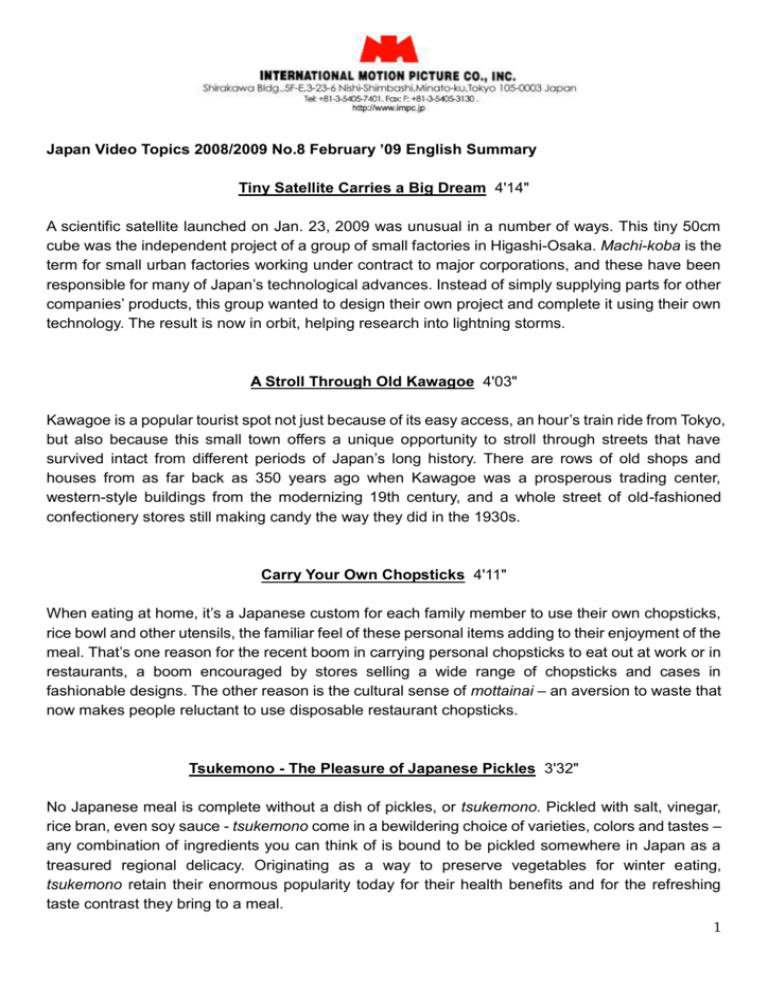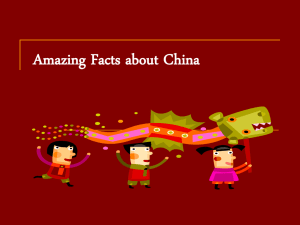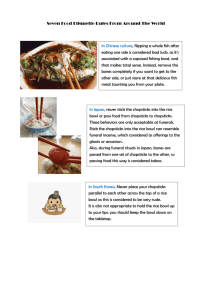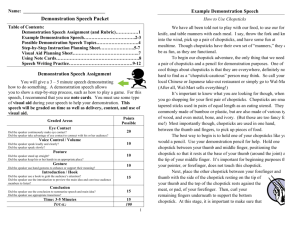word
advertisement

Japan Video Topics 2008/2009 No.8 February ’09 English Summary Tiny Satellite Carries a Big Dream 4'14" A scientific satellite launched on Jan. 23, 2009 was unusual in a number of ways. This tiny 50cm cube was the independent project of a group of small factories in Higashi-Osaka. Machi-koba is the term for small urban factories working under contract to major corporations, and these have been responsible for many of Japan’s technological advances. Instead of simply supplying parts for other companies’ products, this group wanted to design their own project and complete it using their own technology. The result is now in orbit, helping research into lightning storms. A Stroll Through Old Kawagoe 4'03" Kawagoe is a popular tourist spot not just because of its easy access, an hour’s train ride from Tokyo, but also because this small town offers a unique opportunity to stroll through streets that have survived intact from different periods of Japan’s long history. There are rows of old shops and houses from as far back as 350 years ago when Kawagoe was a prosperous trading center, western-style buildings from the modernizing 19th century, and a whole street of old-fashioned confectionery stores still making candy the way they did in the 1930s. Carry Your Own Chopsticks 4'11" When eating at home, it’s a Japanese custom for each family member to use their own chopsticks, rice bowl and other utensils, the familiar feel of these personal items adding to their enjoyment of the meal. That’s one reason for the recent boom in carrying personal chopsticks to eat out at work or in restaurants, a boom encouraged by stores selling a wide range of chopsticks and cases in fashionable designs. The other reason is the cultural sense of mottainai – an aversion to waste that now makes people reluctant to use disposable restaurant chopsticks. Tsukemono - The Pleasure of Japanese Pickles 3'32" No Japanese meal is complete without a dish of pickles, or tsukemono. Pickled with salt, vinegar, rice bran, even soy sauce - tsukemono come in a bewildering choice of varieties, colors and tastes – any combination of ingredients you can think of is bound to be pickled somewhere in Japan as a treasured regional delicacy. Originating as a way to preserve vegetables for winter eating, tsukemono retain their enormous popularity today for their health benefits and for the refreshing taste contrast they bring to a meal. 1 Tiny Satellite Carries a Big Dream 4'14" 01 (Rocket launch) On January 23rd, 2009, the 15th rocket of the H2A series lifted off from Tanegashima Space Center carrying the IBUKI environmental monitoring satellite and seven micro-satellites. One of these, the Maido Ichigo, will research lightning storms. This micro-satellite, just 50 centimeters high, is the result of an independent project organized by a group of small local companies. 02 (Street scene) This is Higashi-Osaka, a district densely packed with small factories. Such small urban factories, known as machi-koba, have long been the pioneers driving innovation in Japanese manufacturing, although almost all their work is done as sub-contractors to major corporations. Each small factory makes only certain specialized parts, and they rarely see the final product. 03 (Web page) Motivated by the desire to use their advanced skills in an independent project of their own, the owners of several of these factories decided to pool their technological resources to build a micro-satellite. 04(Interview – M) “We’ve always been proud of the wide range of skills and technologies we have here in Higashi-Osaka – we can make anything you want, from a toothbrush to a space rocket. Because we mostly just make parts on order for bigger companies, a lot of us were really keen to tackle an entire project ourselves, from planning through to the final product. We learned a great deal by working together to make this satellite.” 05 (Factory) The Maido Ichigo satellite was developed using advanced technologies that these companies had perfected for their normal business. This factory, for example, normally manufactures radio-controlled model helicopters and robots. Their servo motor technology controls a module of the Maido Ichigo called the spin up wheel. This module stabilizes the rotation of the satellite after it separates from the spacecraft and orbits in zero gravity. 06 (Aluminum cylinder with cable) The module’s structure was made by another factory, using the same specialist aluminum machining techniques they normally employ to manufacture components for optical instruments and automobiles. The spin up wheel module structure required the machining of perfectly accurate circles. 07(Interview – M) “The specifications demanded absolutely no distortion. Of course, that’s the same standard we operate to every day in our normal work.” 2 08(Man at computer monitor) They already had the advanced technology needed to make the satellite, but it also had to survive the rigors of the voyage into space. 09(Interview – M) “The conditions are unimaginably different. It’s only for a short time, but the rocket and its payload must withstand unbelievable levels of vibration. We discovered that it would be necessary to greatly strengthen all wiring, connections and casings. So we needed to develop new technologies for that.” 10 (Man soldering) The project generated great enthusiasm among the factory technicians involved. 11(Interview – M) “My job was to make the internal wiring, and I was most worried about ensuring that all the connections would stay firm through the heavy vibrations during the launch. We learned a lot, and I hope we’ll be able to make use of this experience as we develop future similar products such as wiring harnesses for installing on trains.” 12(Rocket launch) Thanks to the dream and the cutting-edge technology of a group of small Osaka factories, the Maido Ichigo satellite is now up there circling the earth. A Stroll Through Old Kawagoe 4'03" 01 (Rickshaw) Kawagoe is an old town in Saitama, just an hour’s train ride from Tokyo Station. One of the few places where you can enjoy the atmosphere of several different historical periods side by side, it’s now a popular tourist spot. 02 (Black building with red counter outside) Streets like this one look much as they would have done in the Edo Period, which lasted from the 17th to the mid 19th century. 03 (Photo of old building) During that period, Kawagoe flourished through trade with nearby Edo, the city we now call Tokyo. Edo was then Japan’s political and cultural center. 04 (Street scene – pedestrian crossing) In 1893, Kawagoe was following the nationwide trend toward modernization when a great fire destroyed one third of the town. The buildings that survived this disaster were the old merchant houses and warehouses constructed in the traditional style called kurazukuri. 05 (Museum exhibit) 3 Kurazukuri buildings have thick walls of pressed earth, which was very resistant to fire. 06 (BW photo) The disaster vividly demonstrated the value of this traditional construction, and Kawagoe’s merchants rebuilt their town in the old style we can still see today. 07 (Interview - F) “For me, coming to this town is like taking a time trip back through Japan’s history.” 08 (Street scene) Kawagoe also has streets of fine old western style buildings. These date back to the mid 19th century, when the age of the samurai was ending and European culture was greatly influencing Japanese ideas about architecture. 09 (Crowded street with confectionery stores) Kashi-ya Yokocho, or Confectionery Row, is lined with stores that still make their own old fashioned candy, filling the air with a sweet aroma. Children delight in searching these mounds of inexpensive goodies, while their parents enjoy the nostalgia of long forgotten tastes. 10 (Couple inside store looking at candy) This store manufactures its own candy by hand, using the old methods. There are not many artisans left who have these skills, and passing the old techniques on to the next generation is seen as an important responsibility. 11 (Interview - F) “Everywhere you look, it’s like the old days. And so many tasty treats to sample.” (Interview - Girl) “It’s fun here.” 12 (Interview - F) “Most visitors spend the day walking round the town and seeing our sights like the old bell tower, the museum and Kita-in Temple. Before they go home, they always end up here in Confectionery Row to buy candies as presents. We meet lots of people who enjoy Kawagoe so much they come back a second and even a third time.” 13 (Bell tower) For three and a half centuries, bells rung from this tower have sounded the passing of the days. So close to the soaring skyscrapers of Tokyo, Kawagoe retains the atmosphere of those far off times. 4 Carry Your Own Chopsticks 4'11" 01 (Mother’s voice) “Keita, put the chopsticks on the table please.” (Child’s voice) “Mummy’s. Daddy’s. Mine. And Shota’s.” When a Japanese family gathers round their dinner table, each person will have their own chopsticks. At home, Japanese use their own personal bowls and utensils, enjoying the feel of familiar objects worn by their own hands. Chopsticks are the most personal item of all, and the one that most affects how you experience your meal. 02 (Restaurant disposable chopsticks) Many restaurants provide disposable chopsticks. But throwing a thing away after just one use offends the traditional Japanese sense of “mottainai”. “Mottainai” is a feeling of respect for things that leads to the avoidance of waste in all aspects of life. And it’s this feeling that is encouraging the fashion for carrying one’s own chopsticks around to use when eating outside the home. 03 (Pan down, restaurant interior) This restaurant gives a discount to customers who bring their own chopsticks. 04[Customer – F] “I bought these because of the cherry blossom pattern. They’re so cute!” 05[Manager – M] “We started this campaign with the environment in mind. And our customers from around here seem to be very receptive to the idea.” 06 (Women about to sit down) It’s an idea that’s catching on rapidly, helped by the availability of portable chopsticks and carrying cases in a wide range of fashionable designs. 07[Woman 1] “These are quite unique, don’t you think?” [Woman 2] “Very cute. Just like their owner.” [Woman 1] “That was my idea.” 08 (Door with giant chopsticks) To cater to the new trend, specialist stores offer a huge range of chopsticks designed for every taste. These chopsticks are made of rolled washi craft paper, resin-treated to make them washable. 5 These are studded with crystals. And these are an interesting combination of wood and ceramic. And of course there are fashionable carrying pouches and cases to match your favorite chopsticks. Some designs even come to pieces to make them easier to fit in a bag or pocket. 09 [Store manager] “Our chopsticks are more than just portable, functional utensils. Because people use them in public places, they want designs that are fashionable, smart or cute, or that somehow express their personal taste. And of course, we believe that a meal you eat with your own chopsticks is simply more delicious than when you use cheap disposable ones.” 10 (Man at table) This growing trend for carrying one’s own personal chopsticks springs from the mottainai habit of avoiding waste, and from the simple delight in a new way to enjoy fashion. Tsukemono - The Pleasure of Japanese Pickles 3'32" 01 (Plate of pickles) Hearty crunching sounds and a distinctive tangy aroma accompany the eating of Japanese pickles, or tsukemono. This indispensable and much loved part of every Japanese meal is the product of a long tradition of preserving vegetables by fermenting them in salt or soy sauce. 02 (Seashore) Each winter, the beach at Miura City in Kanagawa is lined with long rows of drying Japanese radishes, or daikon. This region has a long tradition of pickling radishes. 03 (Sun shining through daikon) After a week drying in the sun, the radishes are then fermented in tubs with salt and rice bran to make the pickles known as takuan. 04 (Pan L over daikon & subtitle) Rice bran is the outer layers of the rice that are removed during milling and polishing. Rich in proteins and fats, the bran greatly adds to the flavor of the pickles. 05 (Field) Pickles were originally a way of preserving vegetables to eat during the winter months when fresh vegetables were hard to obtain. Today, they are often thought of as a health food, providing both fiber and vitamins. Using rice bran helps the preservative effect, but more importantly, it adds extra flavor to the pickled vegetables. The product of traditional farming wisdom, Japanese pickles have evolved into a dish fine enough to be savored by connoisseurs. 6 06 (Field and map) Each region of Japan takes pride in its own unique style of tsukemono. In the cold highlands of Nagano, they make a famous pickle from turnip leaves. This becomes a crisp and refreshing dish when flavored with salt or soy sauce. 07 (Map) Snowy Akita is famous for its radish pickles, dried by a smoking process that gives it a unique flavor. In Wakayama’s mild climate, the farmers pickle umeboshi plums together with red shiso leaves. 08 (Map with photos) Every kind of vegetable is being pickled somewhere in Japan, and the range of ingredients and methods sometimes seems endless. 09 (Pan R over pickles) The wisdom of the old farming communities lives on today in the many types of tsukemono that brighten the dinner tables of Japan. 7 Japan Video Topics 2008/2009 No.8 February ’09 Contact List Tiny Satellite Carries a Big Dream Japan Aerospace Exploration Agency Marunouchi Kitaguchi Building 2F 1-6-5, Marunouchi, Chiyoda-ku Tokyo 102-8260, JAPAN TEL: 03-6266-6400 http://www.jaxa.jp/ SOHLA Creation Core Higashi Osaka Kita-kan 409 1-4-17, Aramoto Kita, Higashi Osaka-shi Osaka 577-0011, JAPAN TEL: 06-6747-8081 http://www.sohla.com/ Sanko Seiki Ltd. 1-1-12, Imazu Minami, Osaka-shi Osaka 538-0043, JAPAN TEL: 06-6968-3951 http://www.sanko-seiki.net/ Dainichi Denshi Co., Ltd. 12-27, Enoki-cho, Suita-shi Osaka 564-0053, JAPAN TEL: 06-6339-6299 http://www.dainichi-el.co.jp A Stroll Through Old Kawagoe Kawagoe City Museum. 2-30-1, Kuruwacho, Kawagoe-shi Saitama 350-0053, JAPAN TEL: 049-222-5399 Tamariki Seika 2-7-7, Motomachi, Kawagoe-shi Saitama 350-0062, JAPAN TEL: 049-222-1386 8 Carry Your Own Chopsticks Ginza Natsuno Chopsticks Store 6-7-4, Ginza, Chuo-ku Tokyo 104-0061, JAPAN http://www.e-ohashi.com/ Tsukemono - The Pleasure of Japanese Pickles Hasegawa Farm 560, Kamimiyata, Minamishimoura-cho, Miura-shi Kanagawa 238-0101, JAPAN TEL: 046-888-0882 9







